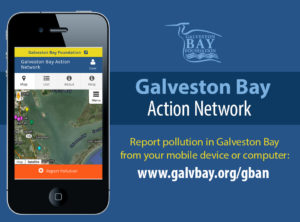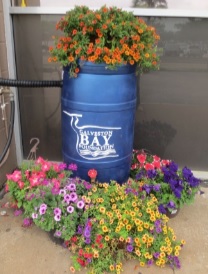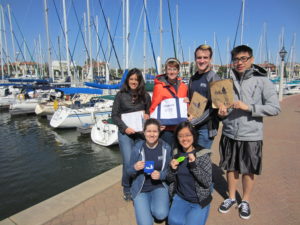The Setting
Galveston Bay has been named an “estuary of national significance” by the United States Congress and the watershed is home to half the population of Texas. Chances are if you live, work, study, or recreate in or around Houston, you directly depend on Galveston Bay in some way. Ninety-five percent of commercially and recreationally important fisheries species in the Gulf of Mexico are dependent upon estuaries like Galveston Bay during some part of their life cycle. Galveston Bay is the most productive bay in Texas.
Getting People’s Attention: “Sexy” Messaging to Affect Actual Behavior
Water quality is not the most zany or attractive topic in which to engage citizens. They know it’s important, but how, really, can they affect change? The Galveston Bay Foundation has launched a successful suite of programs —matching playful and provacative messaging with down-to-earth behaviors—that will empower local citizens to improve water quality in the bay. Who knew that sewer overflows, stormwater runoff, and illegal boat sewage discharges could be interesting?! Galveston Bay Foundation is one of over 100 organizations that have received funding through EPA’s Urban Waters program to improve water quality in urban areas.
Walking the Docks?—Be a Dockwalker! — Walking docks is an everyday activity for many in the Galveston Bay area—they either have a boat, work on boats, service boats, serve food and drink to boaters, or just take their daily walk at the local marina. The Dockwalker Team is a combined data collection-education volunteer program. Particular focus is paid to Clear Lake, which has the third highest concentration of privately owned marinas in the United States and is a key tributary of Galveston Bay. The program emphasizes the environmental harm and human health risk associated with raw sewage and provides boaters with practical tools to help improve water quality on their boat. Volunteers collect boater survey data. Survey data is used to improve educational messaging and materials, as well as collect key statistics needed in watershed planning to reduce fecal bacteria in the bay.
Cease the Grease Campaign – Fats, oil and grease—FOG—down the drain creates major clogs when they congeal and leads to sewer overflows. FOG-related overflows are a big problem around Galveston Bay because they are a source for fecal bacteria—for body contact while swimming or boating, as well as for oyster consumption. The campaign emphasizes the specific ways to dispose of FOG in trash and will include a set up for oil recycling. Partners from across the bay region are helping develop the campaign and will implement it in their portion of the watershed. Many of the creative concepts and graphics are being adopted from a successful campaign in Dallas, providing tens of thousands of dollars of in-kind match to the program.
 Finally—a Mobile Web App to Report and Map Pollution! (I told my mom I’d use my phone for good!)—The frustration that many people feel when seeing trash or pollution is that reporting it is too hard, especially as busy as our lives are. The Galveston Bay Action Network “app” is a simple-to-use way to mark an “X” on the map when you see pollution, and report it at the same time through an instant email to the appropriate authority. This tool provides a way for robust citizen engagement in improving water quality.
Finally—a Mobile Web App to Report and Map Pollution! (I told my mom I’d use my phone for good!)—The frustration that many people feel when seeing trash or pollution is that reporting it is too hard, especially as busy as our lives are. The Galveston Bay Action Network “app” is a simple-to-use way to mark an “X” on the map when you see pollution, and report it at the same time through an instant email to the appropriate authority. This tool provides a way for robust citizen engagement in improving water quality.
Two-for-One: Rain Barrel Workshops help the Garden and Water Quality in the Bay—These workshops, which began in 2013, are now selling out everytime they are held (9 held in 2014, serving 60 to 150 residents each time!). Through partnerships with local Coca-Cola bottling plants, and corporate and non-profit sponsorships, the program is self-sustaining, generating tens of thousands of dollars of in-kind match as well as attracting additional sponsorships. Coca-Cola donates the old syrup barrels which are re -outfitted as rain barrels. Rain barrels help reduce stormwater runoff and pollution reaching the bay, while also providing residents with an easy, at-home method of water conservation.
-outfitted as rain barrels. Rain barrels help reduce stormwater runoff and pollution reaching the bay, while also providing residents with an easy, at-home method of water conservation.
Hooking Community Partners to Communicate Messages—The classic “social diffusion” model is being put to use by Galveston Bay Foundation. This model states that people decide on taking actions because those actions are communicated to them as important and simple to do by trusted and known community partners. Thus, you are more likely to take an action if your buddy from the boat association mentioned its importance than if you only saw a billboard with the message. These programs, while built on credible “word-of-mouth” are also backed by intelligent and focused messaging and “doable” behaviors that truly make a difference in the water quality of Galveston Bay.
Lessons Learned
- Paring the messages down from the broad “improve water quality” to specific behavior-based actions that people can accomplish is key.
- You have to make sure that the actions you are asking for actually make a difference if many people take them. No one wants to work hard and then not make a difference.
- There is no ONE message. You need multiple messages or differing audiences and that’s okay. They can be tied together at the end to “improve water quality.”



